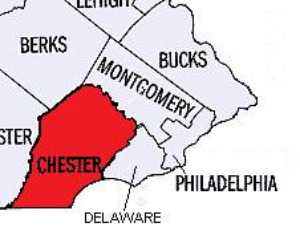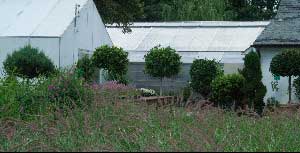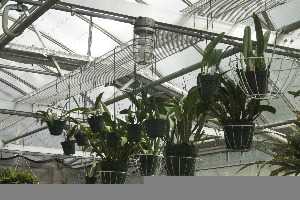Related Topics
Architecture in Philadelphia
Originating in a limitless forest, wooden structures became a "Red City" of brick after a few fires. Then a succession of gifted architects shaped the city as Greek Revival, then French. Modern architecture now responds as much to population sociology as artistic genius. Take a look at the current "green building" movement.

Montgomery and Bucks Counties
The Philadelphia metropolitan region has five Pennsylvania counties, four New Jersey counties, one northern county in the state of Delaware. Here are the four Pennsylvania suburban ones.
City of Homes
At first, there were limitless forests, but then the city burned down. After that, the "Red" city has long been built of brick. Philadelphia's masonry future is unknown, but it won't be wood.
Gardens Flowers and Horticulture
Gardening, flowers and the Flower Show are central to the social fabric of Philadelphia.
Chester County, Pennsylvania
 Chester was an original county of Pennsylvania, one of the largest until Dauphin, Lancaster and Delaware counties were split off. Because the boundaries mainly did not follow rivers or other natural dividers, translating verbal boundaries into actual lines was highly contentious.
Chester was an original county of Pennsylvania, one of the largest until Dauphin, Lancaster and Delaware counties were split off. Because the boundaries mainly did not follow rivers or other natural dividers, translating verbal boundaries into actual lines was highly contentious.
Greenhouses

|
There are lots of mundane activities involved in having a prize show garden, like compost heaps, cold frames, mud rooms, and the like, which competitive show-gardeners never think of talking about, let alone putting on display. However, someone who feels very competitive about the garden usually lets that competitiveness spill over into the greenhouse. Most working greenhouses are muddy and disreputable-looking. When you see a big greenhouse with a spotless floor, however, you know you are learning something about the owner. When tidiness extends to spotless tools and well-sharpened pencils, there's a message. This greenhouse is not merely a tool shed, it's part of the display.
Let's talk about three outstanding greenhouses in the Philadelphia region which are adjuncts to three outstanding horticultural competitors. To spare the feelings of all concerned, the names of the owners will not be mentioned. In one case, the plants are preponderantly indoor plants, a second one is preponderantly filled with outdoor plants, and the third is full of rarities.
The greenhouse full of indoor plants reflects an owner who primarily competes in flower shows in that type of plant, it is true. But this lady obviously brings the flowers to a peak of perfection and then shifts them into the house. The result is a dining area with twenty-five potted flowers scattered tastefully around, dressing up the house. One presumes the flower pots go back to the greenhouse when they start to wilt a little, and probably an effort is made to have plants which flower at different seasons of the year. Back out in the greenhouse, there are dozens of blue ribbons arranged within picture frames to produce pleasing arrangements in themselves. Although this is a famous horticulturalist of long standing, the blue ribbons on display are only awards from fairly recent shows.

|
The second greenhouse to be mentioned is primarily devoted to outdoor plants, being bred and hybridized in controlled circumstances. The owner has created a garden in the interior of a suburban block on the Main Line, and although the houses are all part of the estate, the effect is one of the certain types of plantings in several backyards, a set of sculpted topiaries in one, a formal arrangement of boxwood designs in another, annuals in another. Although the rotation of plantings back and forth from the greenhouse is here probably more of a one-way trip, essentially the greenhouse is serving the same function as the one servicing the indoor display, a place to nurture plantings which are not quite ready for prime time.

|
And the third greenhouse is primarily run by a husband and wife team of horticultural competitors. The other two gardens look as though they employed a dozen or so gardeners, while this one looks like it supports a two-person hobby. It contains a most unusual fern with its own nickname, and dozens of other display specimens of rare and unusual plants to compete in specialty shows of particular varieties. This greenhouse is just as spotless as the ones with much larger staff to do the cleaning, but it seems to have a wider variety of gardener conveniences to lighten the load and increase productivity. One quickly senses that the husband of the team pores over greenhouse catalogs and quickly adopts labor-saving devices. Space is at a premium in this greenhouse, and one guesses its results as much from a need to conserve steps as to conserve space. The effect faintly starts to resemble the jam-packed cockpit of a space-ship.
One technology advance seems to be so superior they all have it. The exterior surface of the greenhouses is not made of glass, but of polycarbonate plastic, sometimes known as "bullet-proof glass". Greenhouses seem a safe enough use for polycarbonate, although widespread use in disposable plastic water bottles seems a more questionable direction for environmental enthusiasm. This transparent material admits the light of a much wider wavelength, particularly ultra-violet, and no doubt greatly extends the season and the effectiveness of indoor nurture. From the photographer's point of view, the resulting pictures are far more pleasing, with diffused light and greater color brilliance. Thus, science has finally achieved for the Philadelphia region the same striking color of light that was so attractive to French Impressionists in southern France, and to vacationers in Hawaii.
The other thing this plastic invention has done has been to increase the general attractiveness of greenhouses. Until rather recently, it was the custom to paint white-wash on the glass and let it slowly weather away as increased sunlight is needed for the plants. Thus, greenhouses once almost always looked shabby and disreputable; not a place you would want seeing by visitors. But nowadays, you just keep them spic and span. And hold a cocktail party there.
REFERENCES
| Standardized Plant Names: American Joint Committee on Horticultural, Frederick Law Olmsted | Google Books |
Originally published: Wednesday, June 16, 2010; most-recently modified: Tuesday, May 21, 2019
| Posted by: J. Gordon | Jul 1, 2010 4:38 PM |
| Posted by: J.Gordon | Jun 30, 2010 11:08 PM |